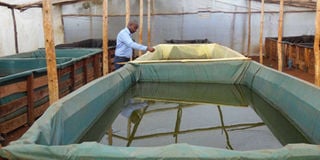Farm small, harvest big; the key lessons under one roof

Roy Kirimi on the fish and seedlings farm on the Methodist Church’s Bio-Intensive Agricultural Centre in Meru. PHOTO| CAROLINE WAMBUI | NATION MEDIA GROUP
What you need to know:
- The farm is home to rabbits, fish, pigs and dairy cows and also hosts a biogas plant and nurseries for various fruits and vegetables.
- The idea behind the farm is that land sizes are shrinking faster and farmers must learn of new ways to produce food on smaller portions of land.
Some 2km from Makutano, on the outskirts of Meru town, sits the Bio-Intensive Agricultural Training Centre, hosted in the Methodist Church in Kenya compound.
Straddling two-and-a-half acres, the centre is a hotbed of agricultural innovation, with farmers trooping there in their droves for lessons.
The farm is home to rabbits, fish, pigs and dairy cows and also hosts a biogas plant and nurseries for various fruits and vegetables.
The idea behind the farm is that land sizes are shrinking faster and farmers must learn of new ways to produce food on smaller portions of land.
On the farm, various varieties of vegetables including onions, spinach and sukuma wiki, among others, occupy eighth acre each. The nursery germination unit sits also on an eighth acre while a banana plantation with sweet potatoes acting as the cover crop occupy an eighth. The livestock section sits on about quarter-acre while the rest of the land hosts the catering and accommodation unit.
At the vegetable farm, the plants are grown in portable vertical gardens, with the several bags hosting between 80 and 150 plants.
“This technology is good because it saves a farmer weeding time, space and water,” says Roy Kirimi, the project manager.
Greenhouses
Other crops including tomatoes, capsicum and onions are planted in four wooden greenhouses, which are cheaper to install. The structures that cost about Sh100,000 are made of wood and a polythene sheet.
The roofs of the greenhouses are fitted with gutters connected to underground pipes that drain to the water reservoir, which has a capacity of 60,000 litres, with all the water being channelled for farm use.
At the aquaculture unit, the fish is kept in greenhouses in 14 floating ponds made from wood and dam liners, each measuring 2m by 6m by 1m and hosting over 3,000 fish.
“With the floating ponds, there is proper management as one can easily regulate the water. The greenhouses help keep the temperatures controlled as a warm environment is guaranteed and predators are also kept at bay.”
Feeds for fish
Cheap feeds for the fish come from the Kienyeji chicken houses above the ponds. The dry chicken manure from some 100 birds drops inside the pond creating a fertile ground for the growth of planktons in water.
They sell an egg for Sh30 while a day-old chick goes for Sh100 and a three-month one for Sh300
Samuel Otieno, the sub-county fisheries officer in Meru, recommends the use of chicken droppings as fish feeds.
“Fish benefits much from the chickens as once the droppings fall into the pond, they settle right at the bottom where with time the insect larvae which the fish feeds on develops. Insects that also thrive on chicken manure act as feed for the fish saving money that one can use to buy commercial feeds for supplementation,” says Otieno.
Biogas
However, he warns that the wet droppings contain bacteria and thus should not find their way into the pond. The farm also rears 12 pigs, the large white breed, which is highly productive.
“The pigs help us to dispose food leftovers from the catering department and thus we save on costs,” says Karimi. The farm keeps four cows, two calves and five goats. Two of the cows are currently in-calf.
“We are currently getting an average of 40 litres, which we supply to the catering unit. The dairy unit occupies less than an eighth acre and supplies the farm with manure enabling us to grow the crops organically,” says Kirimi.
Further, the slurry is collected and used in the production of biogas from their 6 cubic metre plant saving the church on electricity costs. On the other hand, rabbits provide the farm with urine that is used as foliar fertiliser and to control pest.
Organic fertilizer
Jafford Njeru, a natural resource management researcher and a lecturer at Chuka University, says the model helps in maintaining soil fertility through nutrients cycling and is quite beneficial health wise as it employs organic fertiliser and natural control materials thus it enhances better health and wealth.





